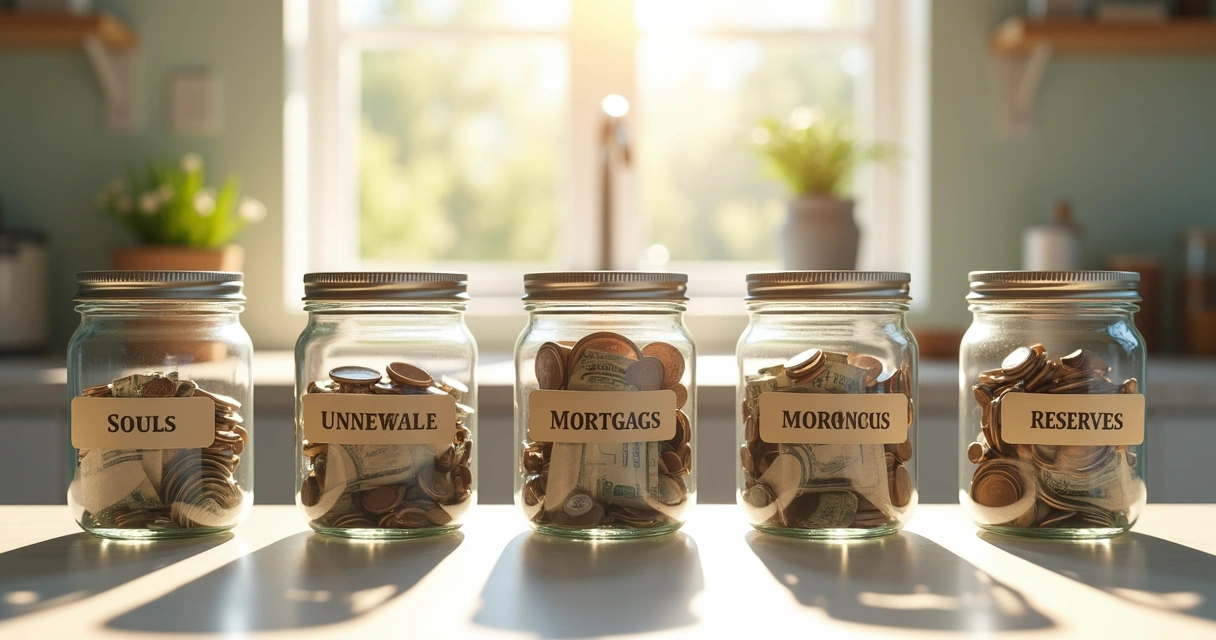Over two decades helping people make their real estate dreams real, I've seen one puzzle trip up even the best-prepared buyers: the reserves requirement in mortgages. Many people hear the term once, and then—maybe because it sounds technical or mysterious—it gets buried in paperwork or overlooked during pre-approval. Yet, it's there, quietly deciding if you get to move forward in your process or not. With the right preparation, it can be just another box you check off confidently.
I want to help you understand reserves from a practical, human angle. If you’re entering the U.S. mortgage world (especially as a first-timer), or you have unique needs and don’t fit the traditional mold, it pays to get unambiguous about what lenders expect from you and why.
Mortgage reserves aren’t just a ‘nice to have’. Sometimes, they’re a must.
Let’s walk through what these reserves actually are, what counts toward them, how they function in lending, and how you can manage or build them—even if your finances are far from perfect.
What are mortgage reserves, and why do lenders care?
I remember a client who proudly shared she’d saved for the down payment and closing costs, then quietly sighed when the bank asked about her “reserves.” She hadn’t planned for months' worth of mortgage payments sitting untouched in her account—and she’s not alone.
Mortgage reserves refer to the funds you have left after paying your down payment and closing costs, meant to cover a set number of months of housing expenses in case something unexpected happens. That means if your job took a turn or an emergency popped up, the lender wants proof that these costs won’t be abandoned. This gives lenders comfort—and makes you a much less risky bet.
In practice, reserves cover your full monthly housing payment: principal, interest, taxes, homeowner’s insurance, and (if needed) HOA dues. This is sometimes abbreviated as “PITI”: Principal, Interest, Taxes, Insurance. If you buy a condo or townhouse that’s part of an association, tack on Association Dues.
Lenders ask about reserves because, in their view, these funds work as a safety net. There’s plenty of data confirming that borrowers with savings fare better over unpredictable months—the Federal Reserve’s mortgage studies show a strong link between having financial cushions and successful loan repayment. So, if you have enough left over to comfortably make a few months of payments, you’re a safer risk, which can mean smoother (and faster) approval.
What qualifies as reserves? Liquid versus non-liquid assets
This is where details matter. In short, not all assets are treated equally when it comes to mortgage reserves. The largest share will come from what lenders call “liquid” sources, or assets you can pull into your checking account quickly—usually within a few days and without big penalties.

- Checking and savings accounts: This is the gold standard—easy access, no penalties, no questions asked.
- Money market funds: Treated similar to checking or savings, as long as you can withdraw without a holding period or big fines.
- Certificates of deposit (CDs): Depending on maturity, may be counted if no penalty for withdrawal or if you’re willing to accept the penalty for immediate access.
- Stocks, bonds, and mutual funds: Usually allowed, but lenders might take the current market value and reduce it by 30% to 40% to factor in possible swings and selling costs.
- Vested retirement accounts (401k, IRA): If you’re fully vested, many lenders will include a portion (typically up to 60% or 70% of value) if you can show you’re allowed to withdraw—even with a tax penalty.
- Trust funds and certain insurance accounts: On a case-by-case basis, if you can access the money quickly and with limited restrictions.
What usually doesn’t count?
- Personal property (like your car or furniture)
- Borrowed funds or cash advances on credit
- Unvested retirement funds, unexercised stock options, or any asset you ‘might’ receive in the future
To lenders, liquidity is king.
They may allow some wiggle room, but if you can’t show proof the funds are genuinely available, they’re probably out.
How do reserves fit into the overall approval process?
At Heart Mortgage, I’ve handled files where the “reserves” box is the final one the underwriter checks before greenlighting a loan. That’s because this step doesn’t come up until underwriting, when the rest of your file—credit, income, property—has already been reviewed. This is particularly true for higher loan amounts, multifamily homes, second homes, or investment properties.
In many loan types, proof of reserves is the difference between conditional approval and final approval. The underwriter sees “two months’ reserves” as two months of safety: if something goes awry with your income, someone else isn’t on the hook for your loan immediately.
Statistically, reserve requirements often go up in markets where lenders see more default risk. According to Federal Reserve housing market reports, mortgage credit can tighten for everyone in a downturn, while lenders scrutinize reserve assets more closely. This can matter a lot for people whose credit or employment isn’t flawless but who are strong savers.
Reserve requirements by loan type
Borrowers are sometimes surprised by how much requirements shift depending on their loan. Here’s a broad overview, based on the most common mortgage types. (If you want a deeper look at types of loans, there’s an easy-to-follow guide at Heart Mortgage’s mortgage loan resource.)
- Conventional loans: For most single-family, owner-occupied homes, two months of reserves (PITI) is common. If you’re buying a second home or investment property, requirements can jump to six months or even more. Jumbo loans (larger amounts above the standard limit) may call for up to 12 months or more. Full breakdown for conventional loans here.
- FHA loans: For single-family homes that you’ll live in, reserves usually aren’t required. However, if you’re purchasing a multi-unit property, or have unexpected factors in your application, you may need as much as three months. Some lenders may even ask for more for borrowers with borderline applications.
- VA loans: Again, no reserves for most single-family homes, but two months (or more) required if you’re purchasing multi-unit properties with fewer than 25% down or if rental income is involved.
- USDA loans: Normally, USDA loans don’t mandate reserves for regular homes, but when your financial profile isn’t rock-solid, the underwriter might ask for proof all the same.
Multi-unit and investment properties always raise the bar.
The logic is simple: If you’re responsible for two or more homes, or you’re buying one as an investment, there’s a bigger risk you might struggle if your income skips a beat. That’s why lenders often want to know you can juggle payments comfortably before signing off.
Reserve rules by property type: Primary, second homes, investment properties
Reserves vary not just by loan, but by what you’re buying and what you plan to do with it. Here’s an outline I often share with clients to clarify what’s expected:
- Primary residence (your main home): Usually the most forgiving. Two months of PITI reserves for conventional loans—not always needed for FHA, VA, or USDA unless there are other risk factors. This is great news for first-timers, who often have just enough to close.
- Second home (vacation or seasonal use): Reserve requirements are almost always more than a main home purchase. You may need six months of reserves, covering both your existing mortgage (if you have one) and the payments on your new second home.
- Investment property (rental or income property): These attract the tightest scrutiny. Lenders generally require six months' reserves for each investment property you finance. In some cases, having more properties can compound the months demanded.
The more homes you own, the higher the reserve bar gets.

How do lenders calculate reserve requirements?
It’s pretty direct: Multiply the monthly housing payment by the reserve factor required (in months). Like so:
- If your all-in payment is $2,000 per month and you need 6 months reserves, that means $12,000 needs to remain accessible in your accounts after closing.
- For two homes, calculate each separately, then add together. So if your main home costs $2,000/mo and you buy a rental at $1,600/mo, and the lender wants 6 months reserves for the rental only, you’d need $9,600 in reserves. But if you own multiple rentals, each can push that number upward.
If you are self-employed or your loan profile is complex, special reserve rules may come into play. Under some circumstances, half of retirement or investment account value can count, but not all—it depends on how quickly and painlessly you can access the funds.
How do your finances affect reserve requirements?
The number of financed properties you own, the property itself, the loan you choose… these shape the months required. But your personal finances matter, too. In keeping with the theme of honest assessment, here’s what I tell my clients:
- Credit score: Higher scores often mean minimum reserve demands. If your credit is below par, the underwriter may ask for more—since solid reserves can offset perceived risk.
- Debt-to-income ratio (DTI): If your monthly debts are a big share of your income, you may be required to show extra reserves. High DTI plus low reserves? That’s almost universally a red flag.
- Employment or income stability: If your income is irregular or subject to big swings (like fluctuating commissions, gig work, or recent job changes), don’t be surprised if the lender asks for a bigger safety net.
- Number of properties financed: This is big. Owning several financed homes (including rentals) can result in the lender adding reserve requirements for each one. Typically, every mortgage you carry (not just the one you’re buying) goes into the calculation.
I find that many buyers underestimate how all these elements combine to play a role in the final underwriter decision. If you want to run scenarios and get clear numbers, guides like the mortgage preapproval guide can help clarify what lenders are looking for.
Practical tips to build and manage reserves
Reserves can be a stumbling block for even diligent savers. If you’re worried you won’t have enough left after your down payment, don’t panic—there are ways to bolster this buffer beyond just hoping for a windfall. Here’s what’s worked for clients I’ve personally helped:
- Start saving early: Even putting aside $100 a week adds up over time. Automate transfers from your checking into a separate “reserves fund,” and you’ll stop thinking of it as ‘spendable’ money.
- Use multiple sources: Lenders allow combining funds from checking, savings, investment accounts, and (sometimes) retirement plans. It rarely needs to be “all from one spot.”
- Adjust your purchase timing: If buying now will leave you with zero reserves, waiting a few months to pad your accounts can make a huge difference in approval odds—and peace of mind.
- Review your non-liquid assets: If you have investments or vested retirement plans, ask how much can be counted. I’ve seen people worry they’re short on cash, not realizing their IRA or brokerage funds qualify (subject to the percentage allowed).
- Gift funds: Some loan types allow gifts from family members or others for reserve purposes, but you’ll want to follow documentation rules closely.
- Minimize other debts: Paying down credit cards or auto loans can lower your DTI, sometimes reducing the reserves needed or making approval possible with what you have saved.
Consistency in saving beats windfalls.

Sometimes, even small habit tweaks (like eating out less, or auto-rounding up purchases to savings) can provided the margin you need.
Sample scenario: Calculating your required reserves
Let me share a straightforward “math story” to give you a sense of how to estimate what’s necessary for your own case:
- Monthly mortgage (PITI): $2,200
- Loan type: Conventional
- Property type: Primary residence
- Reserves required: 2 months
- Needed in reserves: $4,400
Suppose you’re buying a second home at $1,800 monthly payment. Bank asks for six months’ reserves:
- Monthly mortgage (PITI): $1,800
- Reserves required: 6 months
- Needed in reserves: $10,800
If you own three financed properties already and you’re buying a fourth as an investment, expect an even higher sum—often six months for each financed property, added together, though that can vary by lender or risk.
Knowing your reserve number early prevents last-minute headaches.

Long-term peace of mind: Why reserves benefit you, not just your lender
I’ve heard clients grumble, “Why do I need thousands sitting idle after a tough savings journey?” It might feel like a barrier, but in reality, that buffer serves you just as well as it helps the lender. This cushion buys you time if life gets bumpy—maybe you’re laid off, or a surprise bill lands. Instead of scrambling, you have months to get things stable without risking your home or credit.
Having solid reserves provides you freedom and options when something in life doesn’t go as planned. A study based on Federal Reserve loan performance research shows that homeowners with more savings are far less likely to fall behind or default during hard times. Sure, lenders want protection for themselves, but you get the real benefit: fewer sleepless nights, and more breathing room to adjust if you ever need it.

Common pitfalls and how to avoid them
With reserves, a few things trip up buyers. Based on my experience at Heart Mortgage, here’s what to avoid:
- Assuming your down payment is all you need: Check reserve needs in advance for your loan and property type—don’t let it surprise you the week of closing.
- Counting non-liquid assets: If you claim something as reserves, make sure it truly qualifies as accessible cash or near-cash.
- Ignoring the “seasoning” of funds: Lenders ask for recent statements to be sure the funds didn’t just appear overnight from a loan or undisclosed source. Build your reserves organically so you can provide documentation if asked.
- Letting your account balances dip before closing: Don’t spend reserves before the loan funds. Keep your accounts steady until you have the keys in hand.
- Not tracking transfers or gifts: If you’re using gifted money, document the source and paper trail clearly, following your lender’s requirements—uncertainty can cause delays or denials.
For more reassurance, especially for those who don’t fit standard profiles, reading about the first-time buyer experience or special loan paths at Heart Mortgage’s first-time home buyer resource can be very helpful.
Bringing it all together: Take control of your home buying journey
The requirement for mortgage reserves is more than a small detail. It shapes who gets approved and who does not, but also provides real security for buyers facing the unknown. In my years of assisting buyers, I’ve seen how preparation makes all the difference: the borrowers who understand and plan for reserves feel confident throughout the process, not caught off-guard in the final days.
Whether you’re preparing for your first purchase, looking to invest, or simply want that peace of mind, you can take charge:
- Study what your loan and property type requires—including for non-standard situations. The Heart Mortgage blog has resources that answer many of the nuanced questions I get from buyers every week.
- Check every account for qualifying funds, allow time for “seasoning,” and track all transfers. Don’t wait until the last minute to start documenting!
- Start saving in small steps, not with huge, unsustainable jumps. Even a little momentum matters more than you’d think.
- Ask your mortgage professional (or the Heart Mortgage team, if you’re with us) for clarity if you’re unsure how something counts. The right guidance can prevent frustration, delays, or confusion, especially for self-employed or non-traditional buyers.
Ready to get started, or need custom advice for your unique financial situation? Heart Mortgage exists to walk you through every step, offering clear guidance, competitive options, and a personal touch—especially when reserve requirements seem tough or you feel discouraged. Let’s make your home ownership dream real, and create a plan that supports both your loan approval and your peace of mind. Reach out anytime for honest answers, tailored solutions, and the support you deserve.
Frequently asked questions
What are mortgage reserves?
Mortgage reserves are the funds you keep available (but unused) after closing, typically amounting to a set number of months’ worth of your total mortgage payment (including principal, interest, taxes, insurance, and sometimes HOA dues). They act as a cushion, providing your lender assurance that you can keep paying your mortgage even if your income drops temporarily.
How much reserve do I need?
The amount varies by loan type and property. For conventional loans, owner-occupied homes often need two months of reserves; second homes or investments usually need six or more. Government-backed loans (FHA, VA, USDA) may require none for primary homes, but more for multi-unit or higher-risk profiles. Always check with your lender based on your unique scenario.
How do lenders verify reserves?
Lenders verify reserves by reviewing recent bank statements, investment or retirement account balances, and sometimes official letters from your bank or financial institution. The key is to show the money is truly yours, “seasoned” (in your account for over a month), and accessible if needed for payments.
Can gift funds count as reserves?
In some loans, yes—gifted funds from family or approved sources can count, but strict documentation rules apply. This usually includes a formal gift letter, clear evidence of transfer, and sometimes proof the giver has the money to give. Each loan program sets its own limitations, so ask upfront to avoid issues.
Do all loans require mortgage reserves?
No, not always. Many standard FHA, VA, and USDA single-family loans for owner-occupants do not strictly require reserves, though it can help offset other risk factors. Conventional, investment, multi-unit, and second home loans almost always do. It’s always smart to check the current rules before making assumptions.





